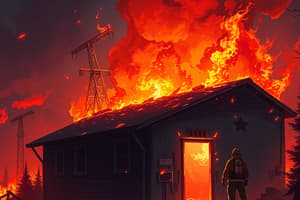Podcast
Questions and Answers
What does 'Shall' indicate in regulatory terms?
What does 'Shall' indicate in regulatory terms?
- Optional compliance measures.
- Mandatory requirements. (correct)
- Preferred methods of operation.
- A suggestion for best practice.
Which of the following best describes a 'Listed' item?
Which of the following best describes a 'Listed' item?
- Equipment with no inspection records.
- Equipment produced without authority oversight.
- Equipment that is under a trial phase.
- Equipment that meets designated standards after testing. (correct)
What is a 'Controlled Stop'?
What is a 'Controlled Stop'?
- Stopping a machine by cutting off all power immediately.
- An automatic stop without safety checks.
- A manual method of shutting down a machine.
- Stopping motion while maintaining power to actuators. (correct)
What defines a 'Hazardous Condition'?
What defines a 'Hazardous Condition'?
What does 'Should' imply in a safety regulation context?
What does 'Should' imply in a safety regulation context?
Which of the following describes the term 'Safety Circuit'?
Which of the following describes the term 'Safety Circuit'?
What is meant by 'Uncontrolled Stop'?
What is meant by 'Uncontrolled Stop'?
What is the significance of compliance for existing machinery under the regulations?
What is the significance of compliance for existing machinery under the regulations?
What is the primary purpose of machine guarding according to the standards?
What is the primary purpose of machine guarding according to the standards?
Which of the following is a method of proving a repeat violation under § 1910.212(a)(1)?
Which of the following is a method of proving a repeat violation under § 1910.212(a)(1)?
In the case of Secretary v Loren Cook, what defense did Cook establish?
In the case of Secretary v Loren Cook, what defense did Cook establish?
What incident prompted OSHA to seek penalties from Wal-Mart in 2018?
What incident prompted OSHA to seek penalties from Wal-Mart in 2018?
What does 1910 Subpart O require concerning hazardous energy control?
What does 1910 Subpart O require concerning hazardous energy control?
Which of these hazards can machine guarding protect against?
Which of these hazards can machine guarding protect against?
What was the economic penalty sought against Wal-Mart for the trolley incident?
What was the economic penalty sought against Wal-Mart for the trolley incident?
Which aspect was critical for establishing a repeat violation in the Secretary v Loren Cook case?
Which aspect was critical for establishing a repeat violation in the Secretary v Loren Cook case?
What is the primary purpose of the Occupational Safety and Health Act of 1970?
What is the primary purpose of the Occupational Safety and Health Act of 1970?
What is the role of the Occupational Safety and Health Administration (OSHA)?
What is the role of the Occupational Safety and Health Administration (OSHA)?
Which of the following is a necessary element to prove a violation of the General Duty Clause?
Which of the following is a necessary element to prove a violation of the General Duty Clause?
What is codified in 29 CFR 1910?
What is codified in 29 CFR 1910?
Under the General Duty Clause, what does an employer need to ensure regarding recognized hazards?
Under the General Duty Clause, what does an employer need to ensure regarding recognized hazards?
What department is OSHA part of?
What department is OSHA part of?
Which of the following is NOT a responsibility of OSHA?
Which of the following is NOT a responsibility of OSHA?
How can an employer demonstrate compliance with the OSH Act?
How can an employer demonstrate compliance with the OSH Act?
What is the definition of risk reduction?
What is the definition of risk reduction?
What does the acronym ALARP stand for?
What does the acronym ALARP stand for?
Which term is considered synonymous with acceptable risk?
Which term is considered synonymous with acceptable risk?
What is the primary safety control method used to prevent inadvertent re-energization of machinery?
What is the primary safety control method used to prevent inadvertent re-energization of machinery?
What are the responsibilities of a supplier in hazardous energy control?
What are the responsibilities of a supplier in hazardous energy control?
Who is responsible for complying with the hazardous energy control program?
Who is responsible for complying with the hazardous energy control program?
Which of the following is NOT a correct definition of lockout?
Which of the following is NOT a correct definition of lockout?
Which regulation outlines the employer's responsibility for employee safety under OSHA?
Which regulation outlines the employer's responsibility for employee safety under OSHA?
What is a key function of protective devices on a machine?
What is a key function of protective devices on a machine?
Where should hand controls be mounted to minimize risks for operators?
Where should hand controls be mounted to minimize risks for operators?
What is the minimum enclosure protection type specified?
What is the minimum enclosure protection type specified?
What color should an emergency stop actuator be?
What color should an emergency stop actuator be?
Which conductor is required to be insulated?
Which conductor is required to be insulated?
What is the requirement for the connections of conductors?
What is the requirement for the connections of conductors?
Which of the following colors is used for ungrounded AC control conductors?
Which of the following colors is used for ungrounded AC control conductors?
What type of conductors is required to be copper?
What type of conductors is required to be copper?
What is the purpose of identification tags on conductors?
What is the purpose of identification tags on conductors?
What should be done to protect conductors against fraying?
What should be done to protect conductors against fraying?
What is required for terminals accepting more than one conductor?
What is required for terminals accepting more than one conductor?
What is the minimum working space in front of control cabinets?
What is the minimum working space in front of control cabinets?
What is the defined characteristic of stranded conductors?
What is the defined characteristic of stranded conductors?
Flashcards are hidden until you start studying
Study Notes
NFPA 79 Key Definitions
- Shall: Indicates mandatory requirements.
- Should: Suggests recommendations or advice, not required.
- Listed: Equipment or services evaluated by an authoritative organization, meeting designated standards.
- Direct Opening Operation: Achieved by the movement of a switch actuator through non-resilient members, without relying on springs.
- Hazardous Condition: A scenario where a person may face immediate or long-term harm.
- Safety Circuit: Part of a control system performing safety-related functions to maintain safety.
- Controlled Stop: Machine halts while retaining power to the actuators.
- Uncontrolled Stop: Machine halts by cutting power, initiating brakes or other mechanical stops.
NFPA 79 Control Functions
- Control Functions in Failure Scenarios:
- Protective devices are essential (interlocks, guards, trip devices).
- Electrical circuits must include protective interlocking.
- Proven circuit techniques and components should be utilized.
- Partial or complete redundancy may be required.
- Functional testing should be provisioned.
NFPA 79 Operator Interface & Control Devices
- Controls must be rigidly mounted in clean, dry areas to minimize damage.
- Hand controls must be positioned at least 0.6 meters above the servicing level.
- Operator positions must avoid hazardous situations and minimize inadvertent operations.
- Start pushbuttons should be above or to the left of stop buttons.
- Emergency stops must be accessible and operable at each control station.
NFPA 79 Control Equipment: Location, Mounting & Enclosures
- Equipment should be easily accessible for maintenance and operation.
- Protective constructions must align with UL standards (e.g., UL 508, UL 508A, NEMA 250).
- Minimum enclosure protection is Type 1.
- Working spaces in front of control cabinets must be at least 762 mm (30 in).
Wiring Practices
- All wire connections need securing against accidental loosening.
- Proper identification is required for connections based on the conductor's type and area.
- Shields on conductors should prevent fraying and allow easy disconnection.
- Tags must be permanent and legible.
- Terminal blocks must be configured to prevent crossover wiring.
Conductors & Cable Requirements
- Conductors must be insulated and made of copper.
- Insulation should be flame retardant.
- Conductors are color-coded for identification (e.g., green for ground, black for ungrounded).
OSH Act and OSHA Overview
- Passed in 1970 to protect workers from workplace hazards.
- OSHA enforces and sets safety standards under the US Department of Labor.
- General Duty Clause requires employers to maintain a hazard-free workplace.
Responsibilities Under OSHA
- Suppliers: Ensure machines are designed for effective hazard control.
- Users: Ought to establish protective programs against hazardous energy.
- Personnel: Must follow the hazardous energy control programs.
Case Studies
- Secretary v Loren Cook: Highlighted compliance issues regarding machine guarding; defense of infeasibility established.
- Secretary v Walmart: Focused on workplace accidents and penalties for safety violations.
Risk Management Terminology
- Risk Reduction: Actions taken to minimize potential hazards.
- Acceptable Risk: Level of risk deemed manageable and justifiable.
- Lockout/Tagout: Procedures to prevent the accidental energization of machinery, crucial for safety in handling hazardous energy.
Learning Objectives
- Cover essential topics including conductors, wiring practices, electric motors, and safety regulations in relation to NFPA 79 standards.
Studying That Suits You
Use AI to generate personalized quizzes and flashcards to suit your learning preferences.




